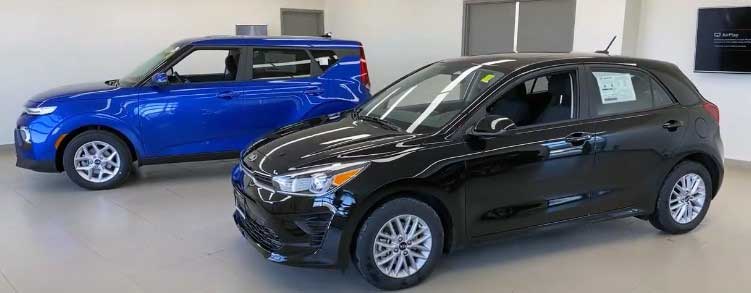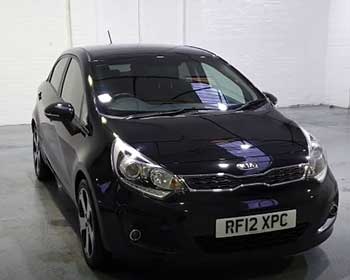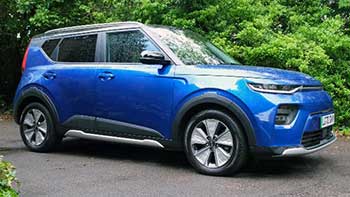I’ve always been fascinated by the challenge of choosing the perfect car, especially when it comes to practical, budget-friendly options like the Kia Rio and Kia Soul. As someone who’s spent countless hours researching and test-driving vehicles, I’m excited to share my insights on these two Kia models.
My goal is to help you navigate their differences, weigh their strengths and weaknesses, and decide which fits your lifestyle. Through a detailed comparison, including a handy table, pros and cons, and answers to common questions, I’ll break down what makes each car unique, so you can drive away confidently.

Comparison Table of Kia Rio vs. Kia Soul
| Feature | Kia Rio (2023) | Kia Soul (2024) |
| Starting MSRP | $17,905 | $21,885 |
| Body Style | Subcompact sedan/hatchback | Subcompact crossover SUV |
| Engine | 1.6L 4-cylinder, 120 hp | 2.0L 4-cylinder, 147 hp |
| Fuel Economy | 32/41 MPG (city/highway) | 29/35 MPG (city/highway) |
| Cargo Space | 13.7 cu. ft. (sedan), 33.5 cu. ft. (hatchback) | 24.2 cu. ft. (seats up), 62.1 cu. ft. (seats down) |
| Interior Space | 89.9 cu. ft. passenger volume | 120.9 cu. ft. passenger volume |
| Infotainment | 8-inch touchscreen, wireless Apple CarPlay/Android Auto | 10.25-inch touchscreen, wireless Apple CarPlay/Android Auto |
| Safety Features | Forward collision warning, lane departure alert | Blind-spot monitoring, adaptive cruise control (higher trims) |
| Reliability Rating | 7.7/10 (iSeeCars) | 7.6/10 (iSeeCars) |
| Warranty | 5-yr/60,000-mile basic, 10-yr/100,000-mile powertrain | 5-yr/60,000-mile basic, 10-yr/100,000-mile powertrain |
| Trim Levels | LX, S | LX, S, GT-Line, EX |
My Journey with Subcompact Cars
I’ve always had a soft spot for subcompact cars. They’re practical, affordable, and perfect for zipping around city streets or embarking on weekend getaways. Over the years, I’ve driven everything from tiny hatchbacks to boxy crossovers, and I’ve learned that each has its own personality. The Kia Rio and Kia Soul caught my attention because they represent two sides of the subcompact coin: the Rio, a sleek, no-nonsense sedan or hatchback, and the Soul, a quirky, spacious crossover with a bold vibe. I’ve test-driven both, scoured forums, and talked to owners to understand what makes these cars tick. My experiences in the automotive world, from navigating crowded urban parking to long highway drives, shape this comparison. I’m here to share what I’ve learned about these vehicles, focusing on their performance, design, technology, and value, so you can make an informed choice.
Design and Style
Kia Rio’s Sleek Appeal

When I first saw the Kia Rio, I was struck by its clean, aerodynamic lines. It’s got a sporty, understated look that doesn’t scream for attention but still turns heads.
The sedan’s streamlined shape and the hatchback’s compact versatility make it a great fit for city dwellers like me who need something easy to park.
The Rio’s LED headlights and modern grille give it a polished edge, and I appreciated how it feels sophisticated without being flashy.
Inside, the cabin is straightforward but functional, with durable plastics and a layout that’s easy to navigate. I found the seats comfortable for short commutes, though they lack the plushness for longer trips. The Rio’s compact size means it’s cozy—perfect for solo drivers or small families, but it can feel tight with a full load of passengers.
Kia Soul’s Quirky Charm
The Kia Soul, on the other hand, is impossible to miss. Its boxy, almost retro design is like nothing else on the road. I’ll admit, when I first saw it, I wasn’t sure if I loved or questioned its bold aesthetic. But after spending time with it, I get the appeal. The Soul’s “tiger-nose” grille and high ground clearance give it a rugged yet playful vibe.
Inside, it’s a revelation. The tall roof and boxy shape create a surprisingly spacious cabin, with headroom and legroom that make it feel like a much larger vehicle. I could stretch out comfortably, and the rear seats offered enough space for friends or family. The Soul’s interior feels more upscale than the Rio’s, with thoughtful touches like available ambient lighting and a larger touchscreen. It’s a car that invites you to embrace its personality.
Performance and Driving Experience
Kia Rio’s Efficient Zip
Driving the Kia Rio feels like slipping into a reliable old pair of sneakers—comfortable and predictable. Its 1.6-liter four-cylinder engine puts out 120 horsepower, which isn’t going to win any races, but it’s plenty for city driving.1 I found the Rio’s continuously variable transmission (CVT) smooth, making the most of the engine’s modest power. Merging onto highways required some planning, as the Rio can feel underpowered at higher speeds.
But where it shines is fuel efficiency—32 MPG in the city and 41 MPG on the highway, according to the EPA. During my test drives, I loved how the Rio handled tight turns and parking lots with ease. The suspension absorbs bumps well, though I noticed some wind noise at higher speeds, which was a minor annoyance on long drives.
Kia Soul’s Punchy Performance
The Kia Soul, with its 2.0-liter four-cylinder engine and 147 horsepower, feels noticeably peppier. I enjoyed the extra kick when accelerating, especially on open roads. The Soul offers a turbocharged option on higher trims, which I didn’t test but heard adds a sporty edge for those craving more power. Its intelligent variable transmission is responsive, and the slightly higher ground clearance made it feel capable on light gravel or uneven roads.

Fuel economy is solid but trails the Rio, with 29 MPG city and 35 MPG highway.
I found the Soul’s handling surprisingly agile for its boxy shape—it turns on a dime, as one owner put it.
The ride is smooth, though the engine can get loud when pushed, reminding me it’s still an economy car at heart.
Pros of Kia Rio Performance:
- Excellent fuel efficiency (32/41 MPG city/highway).
- Lightweight, making it easy to maneuver in cities.
Cons of Kia Rio Performance:
- Underpowered engine (120 hp) for highway driving.
- Limited to CVT, no manual option.
Pros of Kia Soul Performance:
- Stronger base engine (147 hp) than the Rio.
- Responsive handling; feels capable on light gravel.
Cons of Kia Soul Performance:
- Engine can get loud when pushed.
- Trails the Rio in fuel economy.
Interior Space and Comfort
Kia Rio’s Cozy Cabin
The Rio’s interior is all about efficiency. With 89.9 cubic feet of passenger volume, it’s adequate for four adults, but five feels like a squeeze. I found the front seats supportive enough for my daily commute, but on a two-hour road trip, I wished for more cushioning. The sedan’s trunk offers 13.7 cubic feet, while the hatchback bumps that to 33.5 cubic feet with the seats up—decent for groceries or a weekend’s worth of luggage. The layout is intuitive, with physical knobs and buttons that I appreciated for their simplicity. However, the materials are basic, and there’s no mistaking the Rio for a luxury vehicle. It’s practical, but it doesn’t pamper.
Kia Soul’s Spacious Sanctuary
The Soul’s interior is where it pulls ahead. With 120.9 cubic feet of passenger volume, it feels like a mini-SUV. I could sit upright without brushing the ceiling, and rear passengers had ample legroom. The cargo space is a game-changer—24.2 cubic feet with seats up and 62.1 cubic feet with them folded. I easily fit a mountain bike (with the front wheel off) and still had room for gear. The seats are more comfortable than the Rio’s, and higher trims offer upgrades like heated seats and premium materials. The Soul’s cabin feels airy and versatile, making it ideal for road trips or hauling bulky items.
Technology and Infotainment
Kia Rio’s Practical Tech
The Rio comes with an 8-inch touchscreen that’s crisp and user-friendly. Wireless Apple CarPlay and Android Auto were a pleasant surprise, letting me seamlessly connect my phone for navigation and music. The six-speaker audio system is decent for a budget car, though it lacks the punch for audiophiles. I liked the straightforward controls—knobs and buttons make it easy to adjust settings without taking my eyes off the road. Higher trims add features like push-button start and automatic climate control, but even the base model feels well-equipped for its price. My only gripe was the small rearview camera display, which could be sharper.
Also Read: Kia Niro vs. Kia Soul
Kia Soul’s Modern Edge
The Soul steps up the tech game with a standard 10.25-inch touchscreen on higher trims, which I found bright and responsive. Wireless Apple CarPlay and Android Auto are standard, and the interface is intuitive, with clear menus and quick load times. The available premium sound system was a treat, delivering richer audio than the Rio’s setup. I also appreciated extras like wireless charging and ambient lighting on upper trims, which add a touch of class. The Soul’s tech feels more modern, but even the base model covers the essentials well. It’s a car that keeps you connected and entertained, whether you’re stuck in traffic or cruising cross-country.
Safety Features
Kia Rio’s Solid Safety
Safety is a priority for me, and the Rio doesn’t disappoint. It earned strong crash-test scores from the IIHS, though it fell short in the passenger-side small overlap test. Standard features include forward collision warning, lane departure alerts, and automatic emergency braking. I felt confident with these systems, especially in busy urban settings where quick reactions matter. The Rio’s backup camera is clear, though I wished for blind-spot monitoring, which isn’t standard. For a budget car, the Rio’s safety suite is impressive, giving me peace of mind without breaking the bank.
Kia Soul’s Advanced Protection
The Soul goes a step further with available features like blind-spot monitoring, rear cross-traffic alerts, and adaptive cruise control on higher trims. Its IIHS scores are excellent across the board, and I felt secure knowing the Soul’s robust safety systems had my back. The lane-keep assist was particularly helpful on long drives, gently nudging the car back into its lane when I drifted. The Soul’s higher ground clearance also improves visibility, reducing blind spots. While both cars prioritize safety, the Soul’s additional tech makes it feel like a more comprehensive package.
Pricing and Value
Kia Rio’s Budget-Friendly Appeal
The Rio’s starting price of $17,905 makes it one of the most affordable new cars on the market. I was impressed by how much value Kia packs into this price point—decent tech, solid fuel economy, and a stellar 10-year/100,000-mile powertrain warranty. Maintenance costs are low, and the Rio’s reliability rating of 7.7/10 from iSeeCars suggests it’ll last. For budget-conscious buyers like me, the Rio feels like a smart investment, especially if you’re after a no-frills commuter. However, the lack of premium features might leave some wanting more.
Kia Soul’s Versatile Value
The Soul starts at $21,885, which is higher but justified by its larger size, extra power, and enhanced features. Its reliability rating of 7.6/10 is nearly as good as the Rio’s, and the same generous warranty applies. I found the Soul’s higher trims tempting, with extras like a turbo engine and advanced safety tech, but even the base model feels well-rounded. The Soul’s resale value isn’t as strong as the Rio’s (37.1% depreciation vs. 29% over five years), but its versatility makes it a compelling choice for those who need more space and flair.
Pros and Cons of Kia Rio
- Affordable Price: Starting at $17,905, it’s a steal for a new car.
- Excellent Fuel Economy: 32/41 MPG makes it a champ at the pump.
- Nimble Handling: Perfect for city driving and tight parking spots.
- Strong Warranty: 10-year/100,000-mile powertrain coverage is hard to beat.
- Reliable: A 7.7/10 reliability rating means fewer worries.
Cons
- Underpowered Engine: 120 hp struggles on highways.
- Limited Cargo Space: Sedan’s 13.7 cu. ft. trunk feels cramped.
- Basic Interior: Materials are durable but not luxurious.
- Fewer Safety Features: Lacks blind-spot monitoring on base trims.
- Tight Rear Seating: Not ideal for larger passengers.
Pros and Cons of Kia Soul
- Spacious Interior: 120.9 cu. ft. of passenger space feels SUV-like.
- Generous Cargo Room: Up to 62.1 cu. ft. with seats down.
- Modern Tech: 10.25-inch touchscreen and premium audio options.
- Bold Design: Stands out with its unique, boxy aesthetic.
- Advanced Safety: Blind-spot monitoring and adaptive cruise on higher trims.
Cons
- Higher Price: Starts at $21,885, more than the Rio.
- Lower Fuel Economy: 29/35 MPG isn’t as efficient.
- Noisy Engine: Gets loud under hard acceleration.
- Polarizing Looks: Boxy design isn’t for everyone.
- Slightly Lower Reliability: 7.6/10 vs. Rio’s 7.7/10.
My Take on Choosing Between Them
After spending time with both cars, I see the Rio as the practical choice for solo drivers or small families who prioritize affordability and fuel savings. It’s a no-fuss car that gets the job done, especially for city commutes. The Soul, however, is the better pick if you need versatility, space, and a bit of personality. Its crossover design and tech upgrades make it feel like a step up, though you’ll pay more for it. I leaned toward the Soul for its roominess and fun vibe, but the Rio’s budget-friendly nature is hard to ignore. Your choice depends on what you value most—efficiency or flexibility.
Read More: Kia Carnival vs. Kia Sedona
Frequently Asked Questions (FAQ)
It depends on your needs. The Rio is better for budget-conscious buyers and city driving due to its lower price and better fuel economy. The Soul excels for those needing more space, versatility, and advanced tech.
Kia discontinued the Rio in the U.S. after 2023 to focus on larger, more profitable models like SUVs and crossovers, reflecting market trends favoring bigger vehicles.
The Rio has a weak engine for highway driving, limited cargo space, basic interior materials, fewer advanced safety features, and cramped rear seating.
The Soul’s popularity comes from its unique design, spacious interior, generous cargo space, modern tech, and strong safety ratings, appealing to young drivers and small families
Conclusion
Choosing between the Kia Forte and Kia Rio comes down to your priorities. If you want a compact sedan with more power, space, and tech, the Forte is your pick—I found its versatility perfect for my varied driving needs. If budget and fuel efficiency top your list, the Rio’s affordability and simplicity make it a gem, as I discovered during my budget-conscious test drives. Whichever you choose, both offer great value and Kia’s unbeatable warranty. Take a test drive, weigh your needs, and you’ll find the right fit for your journey.

